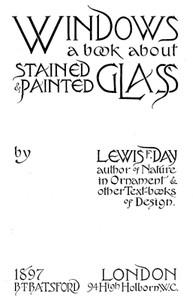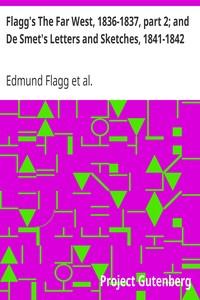|
|
Read this ebook for free! No credit card needed, absolutely nothing to pay.Words: 50952 in 13 pages
This is an ebook sharing website. You can read the uploaded ebooks for free here. No credit cards needed, nothing to pay. If you want to own a digital copy of the ebook, or want to read offline with your favorite ebook-reader, then you can choose to buy and download the ebook.

: Windows: A Book About Stained & Painted Glass by Day Lewis F Lewis Foreman - Glass painting and staining@FreeBooksWed 07 Jun, 2023 riod, painting is often so delicate that bars and leads unquestionably hurt it. It is so even in the very fine Jesse window at Beauvais . Occur where it may it is a false note which stops our admiration short; and, after all our enthusiasm, we come back heart-whole to our delight in the earlier, bolder, more monumental, and more workmanlike mosaic glass. The beautiful sixteenth century work at Montmorency or at Conches does not shake the conviction of the glass-lover, that the painter is there a little too much in evidence, that something of simple, dignified decoration is sacrificed to the display of his skill. The balance between glass decoration and picture is perhaps never more nearly adjusted than in some of the rather earlier Italian windows. LANDSCAPE IN GLASS. The sky had of course from the first been indicated by a blue background; but, the blue ground being used, in alternation with ruby, for all backgrounds, except a few in white, it was not distinctive enough to suggest the heavens, without some indication of clouds, which accordingly were leaded up upon it, sometimes in mere streaks of colour, sometimes in fantastically ornamental shapes. It was a later thought, which came with the use of paler glass, to paint the blue with clouds, indicating them, that is to say, more or less in the form of diaper. As with the sky so with the sea. It was at first glazed in wave pattern; eventually the wave lines were painted on the blue. The blue background, which had gradually become paler and paler, became soon in the sixteenth century pale enough to stand approximately for a grey-blue sky, on which was painted, with marvellous delicacy, distant landscape, architecture, or what not, always in the brown tint used generally for shading, although a tint of green was given to grass and trees by the use of yellow stain. This distant view painted upon blue was a beautiful and most characteristic feature of sixteenth century glass. The French painters adopted it, and made it peculiarly their own, though it occurs also in German and Flemish glass. Backgrounds of this kind, which in themselves suffice to mark the departure from Gothic use, are shown on pages 207, 213, and on a larger scale opposite. The wintry landscape there with the bare tree trunks against the cold grey sky, forms the upper portion of the subject shown on page 207, in which Our Lord gives His charge to Peter; the paler grey behind the heads of the group stands for the sea. The wintry effect of the scene is not suggestive of the Holy Land, but it brings the subject innocently home to us. The leads, it will be seen, take the lines of the larger limbs of the trees, whilst the lesser branches and small twigs are painted on the glass. There is ingenuity in the glazing as well as delicacy in the painting. This is a very different thing from the landscape painted in enamel colours. The propriety, the beauty, the decorative quality of such work as this, comes of the acceptance of the necessary convention of treating the painted background, of rendering it, that is, always more or less in monochrome, and not attempting anything like realism in colour. Sometimes, as at Ecouen, far-off architecture would be painted not upon blue but upon a pale purple hill. At Laigle figures and animals are painted upon green, but they do not hold their own. On the other hand, at Alen?on, some distant figures appearing in very pale grey against a delicate greenish landscape , are charming in effect. White backgrounds painted as delicately as the blue are not rare. At Groslay, for example, steely-white architecture is separated from white sky beyond by grey-blue hills, a church with blue steeple breaking the sky. But white does not lend itself so readily to combination with colour as blue; and, as a rule, such backgrounds are grisaille in character, relieved, of course, with stain. The great sea-scape at Gouda , representing the taking of Dalmatia in Egypt , is nearly all in grisaille, against quarries of clear white, with only a little stain in the flags and costumes, and one single touch of poor ruby , which looks as if it might be modern. The port in perspective, the ships, the whole scene, in fact, is realistically rendered, and comes as near to success as is possible in glass. Delightful peeps of landscape are sometimes seen through the columns and arches of an architectural background. Whether the architecture be in purple of divers shades, or in white with only shadows in purple, or whether the nearer architecture be in white and the more distant in purple, in any case a distance beyond is commonly painted upon the grey-blue sky seen through it. Possibly, as at Conches, further vistas of architecture may be stained greenish upon it--any colour almost, for a change. But whatever it may be, and wherever it may be, in the best work it is colour; and it is always more effective than where the shadow is represented by paint, even though the brown be not laid on with a heavy hand, infinitely more effective than when blue or other coloured enamels are relied upon, as in some instances at Montmorency. Enamel may, for all one can tell, have been used in some of the landscapes here commended--it is impossible to say without minute examination of the glass, which is rarely feasible--but it never asserts its presence; and in any case it has not been used in sufficient quantity to damage the effect. It will be gathered from the descriptions of early sixteenth century glazed and painted distances, that they were as carefully schemed with a view to glazing as a Gothic picture. Sometimes, as at Conches, they are rather elaborately leaded; and where that is the case there is not so much danger of incongruity between the delicacy of the painting and the strength of the leads--which assert themselves less than where they occur singly. It stands to reason also that the more mosaic the glass the less fragile it is. Painting alone upon the blue is best employed for small peeps of distance. It adapts itself to smaller windows; and it must be done so well, that it seems as if the designer must himself have painted it. Were the artist always the glass painter, and the glass painter always an artist, who knows what case pictorial glass might not make out for itself? It is a coarser kind of distance than the French that we find at King's College, Cambridge. There the landscape backgrounds are in white and stain, grey-blue being reserved for the sky beyond, broken more or less by white clouds, or, occasionally, by the white trunks of trees, the foliage of which is sometimes glazed in green glass, sometimes painted upon the blue and stained. Here and there a distant tree is painted entirely upon the blue. This treatment is not ill adapted to subjects on the large scale of the work at King's College, but one does not feel that the painters made anything like the most of their opportunity. The inexperience of the designers is shown in their fear of using leads, a most unnecessary fear, seeing that, at the distance the work is from the eye, the bars themselves have only about the value of ordinary lead lines. Stronger and more workmanlike, but not quite satisfactory, is the much later landscape of Dirk Crabeth at Gouda. There the sky is blue, leaded in quarries, on which are trees, painted and stained, and some rather florid clouds. In the later work generally the lead lines are no longer either frankly acknowledged or skilfully disguised. The outline of a green hill against the sky will be feebly softened with trivial little twigs and scraps of painted leafage. The decline of landscape is amply illustrated at Troyes. At Antwerp again there is a window bearing date 1626, in which the landscape background of a quite incomprehensible subject extends to a distant horizon, above which the sky is glazed in white quarries, with clouds painted upon it. This is an attempt to repeat the famous feat of glass painting which had been done some twenty years before at Gouda. The Relief of Leyden, of which a diagram is here given, is in its way a most remarkable glass picture. In the foreground is a crowd of soldiers and citizens, upon the quay, about lifesize. They form a band of rich colour at the base of the composition; but the design is confused by the introduction of shields of arms and their supporters immediately in front of the scene. Beyond are the walls and towers of the city of Delft, and the adjacent towns and villages, and the river dwindling into the far distance where Leyden lies--in the glass a really marvellous bird's-eye view over characteristically flat country. The horizon extends almost to the springing line of the window arch, and above that rises a sky of plain blue quarries, broken only towards the top by a few bolster-like and rather dirty white clouds. Absolute realism is of course not reached, but it is approached near enough to startle us into admiration. It is astonishing what has here been done. But the painter has not done what he meant to do. That was not possible, even with the aid of enamel. Free books android app tbrJar TBR JAR Read Free books online gutenberg More posts by @FreeBooks
: Flagg's The Far West 1836-1837 part 2; and De Smet's Letters and Sketches 1841-1842 by Flagg Edmund Smet Pierre Jean De Thwaites Reuben Gold Editor - West (U.S.) Description and travel; Indians of North America Missions; Rocky Mountains; Illinois Descripti@FreeBooksWed 07 Jun, 2023

: Abolitionism Exposed! Proving the the Principles of Abolitionism are Injurious to the Slaves Themselves Destructive to This Nation and Contrary to the Express Commands of God by Sleigh W W William Willcocks - Slavery United States; African Americans Colon@FreeBooksWed 07 Jun, 2023
|
Terms of Use Stock Market News! © gutenberg.org.in2025 All Rights reserved.






